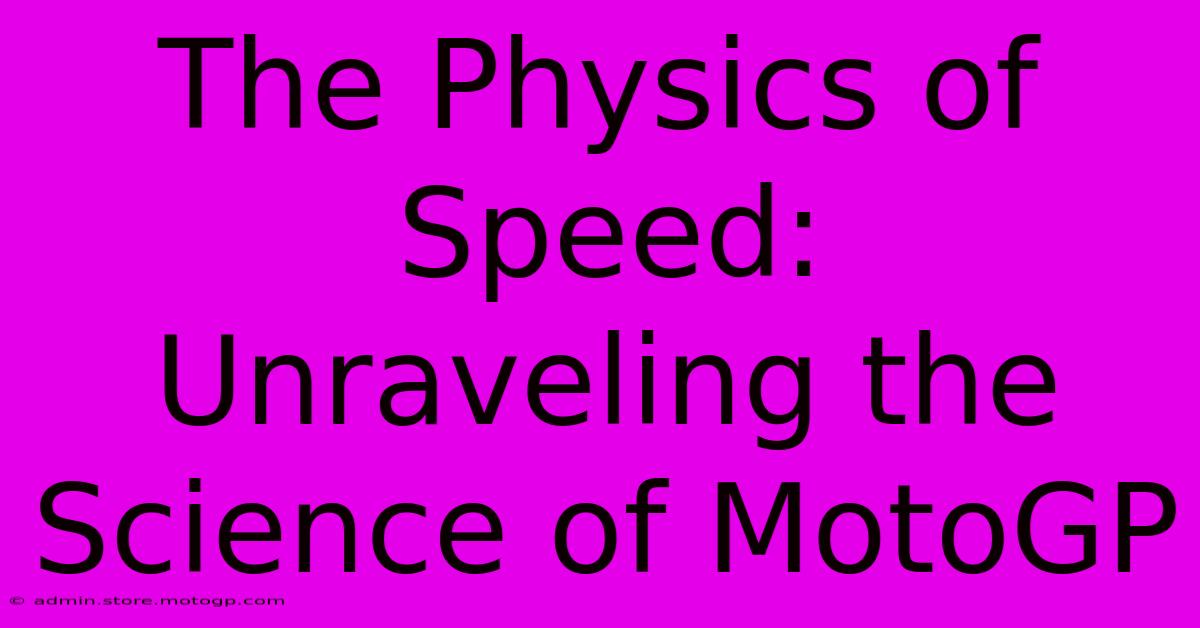The Physics Of Speed: Unraveling The Science Of MotoGP

Table of Contents
The Physics of Speed: Unraveling the Science of MotoGP
MotoGP. The name conjures images of screaming engines, breathtaking leans, and riders pushing the boundaries of human and machine capability. But beyond the thrill and spectacle lies a fascinating world of physics, a complex interplay of forces that dictates every maneuver, every overtake, every victory. This article delves into the science behind the speed, exploring the key physical principles that govern the world's most prestigious motorcycle racing championship.
Aerodynamics: The Unsung Hero
Aerodynamics plays a pivotal role in MotoGP, influencing both speed and stability at incredibly high velocities. The sleek, sculpted fairings aren't just for show; they're meticulously designed to minimize drag and maximize downforce.
Minimizing Drag: The Pursuit of Speed
Drag, the resistance a body experiences as it moves through a fluid (air in this case), is the enemy of speed. MotoGP bikes are engineered to minimize drag through:
- Streamlined Design: The aerodynamic shaping of the fairing directs airflow smoothly around the bike, reducing turbulence and resistance.
- Winglets and Aerodynamic Aids: These carefully positioned appendages generate downforce while minimizing drag, improving stability at high speeds and in corners. The design and placement are constantly evolving, reflecting ongoing aerodynamic research.
- Rider Positioning: The rider's posture also contributes to minimizing drag. A tucked-in position reduces the frontal area exposed to the airflow.
Maximizing Downforce: Cornering Mastery
Downforce, the force pushing the bike downwards, is crucial for high-speed cornering. It provides essential grip, allowing riders to lean into turns at incredible angles without losing control. Sources of downforce include:
- Aerodynamic Fairings: The shape of the fairing itself generates downforce.
- Winglets: These are particularly effective in generating downforce, particularly at high speeds.
- Tire Grip: While not strictly aerodynamic, tire grip is inextricably linked to downforce. The more downforce, the more contact the tires have with the track, resulting in better grip.
The Mechanics of Motion: Forces in Play
Understanding MotoGP requires grasping fundamental physics principles like:
- Newton's Laws of Motion: These laws govern the bike's acceleration, deceleration, and cornering. Newton's first law (inertia) explains why a bike continues moving in a straight line unless acted upon by a force. Newton's second law (F=ma) shows how the engine's force accelerates the bike. Newton's third law (action-reaction) explains how the bike's tires grip the track.
- Centripetal Force: This is the force that keeps the bike moving in a circular path during cornering. It's a combination of friction between the tires and the track, and the downforce generated by the aerodynamics.
- Friction: Friction between the tires and the track is paramount. It provides the necessary grip for acceleration, braking, and cornering. Tire compounds and track conditions significantly affect friction.
Tire Technology: The Grip Factor
Tires are a critical component of MotoGP performance. They're not just rubber; they're highly engineered marvels that must cope with immense forces. The compound, construction, and profile of the tires are meticulously chosen to optimize grip based on track conditions and weather.
Tire Wear and Degradation: A Constant Challenge
Tire wear is a significant factor in MotoGP races. The high speeds, extreme lean angles, and aggressive riding styles put immense stress on the tires, leading to wear and degradation. This degradation affects grip, requiring strategic tire management from both the riders and teams.
The Human Element: Rider Skill and Physics
While the machines are marvels of engineering, the rider's skill is the ultimate determinant of success. Riders must intuitively understand and manipulate the forces acting on the bike, making subtle adjustments to maintain control and optimize speed. Their fitness, reflexes, and decision-making skills are as crucial as the bike's performance.
Conclusion:
MotoGP is a thrilling display of speed and skill, but it's also a masterclass in physics. Understanding the principles of aerodynamics, mechanics, and tire technology reveals the intricate science that underpins this high-octane sport. The interplay between these elements, combined with the exceptional skill of the riders, creates a truly mesmerizing spectacle.

Thank you for visiting our website wich cover about The Physics Of Speed: Unraveling The Science Of MotoGP. We hope the information provided has been useful to you. Feel free to contact us if you have any questions or need further assistance. See you next time and dont miss to bookmark.
Featured Posts
-
Moto Gp Photoshoot Celebrating The Sport
Feb 18, 2025
-
Motorcycle Racing Categories Inspiring Stories Of Success
Feb 18, 2025
-
Moto Gps Most Spectacular Crashes
Feb 18, 2025
-
Feel The Thrill Of Victory Ex Factory Race Bikes
Feb 18, 2025
-
Moto Gp Watch High Definition Streaming
Feb 18, 2025
